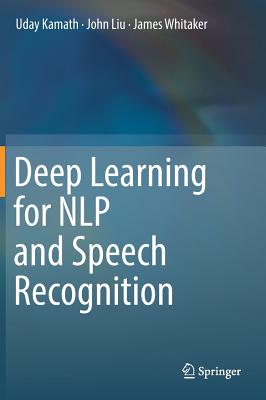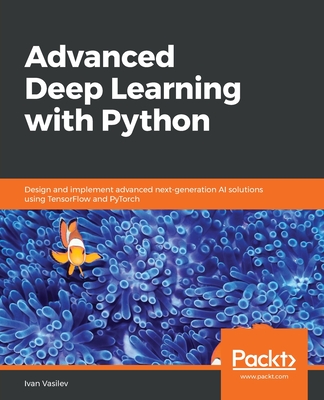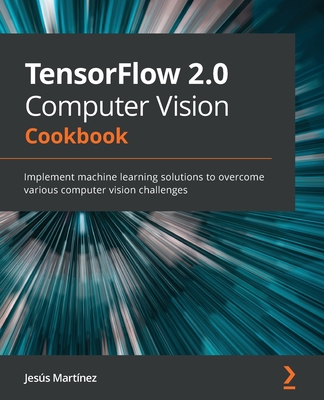Hands-On Neural Networks with Keras
暫譯: 使用 Keras 的實作神經網絡
Niloy Purkait
- 出版商: Packt Publishing
- 出版日期: 2019-03-30
- 售價: $1,380
- 貴賓價: 9.5 折 $1,311
- 語言: 英文
- 頁數: 462
- 裝訂: Paperback
- ISBN: 1789536081
- ISBN-13: 9781789536089
-
相關分類:
DeepLearning
立即出貨 (庫存=1)
買這商品的人也買了...
-
 機率系統與隨機信號 (Probabilistic Systems and Random Signals)
機率系統與隨機信號 (Probabilistic Systems and Random Signals)$450$405 -
 Docker 錦囊妙計 (Docker Cookbook)
Docker 錦囊妙計 (Docker Cookbook)$680$537 -
 Natural Language Processing: Python and NLTK
Natural Language Processing: Python and NLTK$3,220$3,059 -
 Deep Learning with Python (Paperback)
Deep Learning with Python (Paperback)$1,880$1,786 -
 Deep Learning 深度學習基礎|設計下一代人工智慧演算法 (Fundamentals of Deep Learning: Designing Next-Generation Machine Intelligence Algorithms)
Deep Learning 深度學習基礎|設計下一代人工智慧演算法 (Fundamentals of Deep Learning: Designing Next-Generation Machine Intelligence Algorithms)$620$490 -
 $280機器學習vs復雜系統
$280機器學習vs復雜系統 -
 學會 TensorFlow 之後呢?最尖端的 21個夢幻範例實作
學會 TensorFlow 之後呢?最尖端的 21個夢幻範例實作$680$578 -
 初探深度學習|使用 TensorFlow (TensorFlow for Deep Learning: From Linear Regression to Reinforcement Learning)
初探深度學習|使用 TensorFlow (TensorFlow for Deep Learning: From Linear Regression to Reinforcement Learning)$480$379 -
 $301自製 AI 圖像搜索引擎
$301自製 AI 圖像搜索引擎 -
 Neural Networks with Keras Cookbook
Neural Networks with Keras Cookbook$1,380$1,311 -
 Docker 工作現場實戰寶典 (Docker Cookbook, 2/e)
Docker 工作現場實戰寶典 (Docker Cookbook, 2/e)$520$411 -
 CV+ 深度學習:AI 最完整的跨套件 Python 人工智慧電腦視覺
CV+ 深度學習:AI 最完整的跨套件 Python 人工智慧電腦視覺$650$514 -
 $281PyTorch 深度學習 (Deep Learning with PyTorch: A practical approach to building neural network models using PyTorch)
$281PyTorch 深度學習 (Deep Learning with PyTorch: A practical approach to building neural network models using PyTorch) -
 $3,780Deep Learning for Nlp and Speech Recognition (Hardcover)
$3,780Deep Learning for Nlp and Speech Recognition (Hardcover) -
 $327Python數據科學與機器學習 從入門到實踐
$327Python數據科學與機器學習 從入門到實踐 -
 $454Go 語言高級編程
$454Go 語言高級編程 -
 知識圖譜:方法、實踐與應用
知識圖譜:方法、實踐與應用$708$673 -
 $374深度學習原理與 PyTorch 實戰
$374深度學習原理與 PyTorch 實戰 -
 $611深度學習與圖像識別:原理與實踐
$611深度學習與圖像識別:原理與實踐 -
 MongoDB 從入門到商業實戰
MongoDB 從入門到商業實戰$714$678 -
 動手做深度強化學習 (Deep Reinforcement Learning Hands-On)
動手做深度強化學習 (Deep Reinforcement Learning Hands-On)$690$455 -
 機器學習實務|資料科學工作流程與應用程式開發及最佳化 (Machine Learning in Production: Developing and Optimizing Data Science Workflows and Applications)
機器學習實務|資料科學工作流程與應用程式開發及最佳化 (Machine Learning in Production: Developing and Optimizing Data Science Workflows and Applications)$580$493 -
 雲端深入你我身邊:新一代邊緣運算技術直達
雲端深入你我身邊:新一代邊緣運算技術直達$650$514 -
 Python GUI 設計活用 tkinter之路 — 王者歸來, 3/e
Python GUI 設計活用 tkinter之路 — 王者歸來, 3/e$680$537 -
 最佳能效晶片平台 - ARM64 架構師高度之程式開發
最佳能效晶片平台 - ARM64 架構師高度之程式開發$980$718
商品描述
Key Features
- Design and create neural network architectures on different domains using Keras
- Integrate neural network models in your applications using this highly practical guide
- Get ready for the future of neural networks through transfer learning and predicting multi network models
Book Description
Neural networks are used to solve a wide range of problems in different areas of AI and deep learning.
Hands-On Neural Networks with Keras will start with teaching you about the core concepts of neural networks. You will delve into combining different neural network models and work with real-world use cases, including computer vision, natural language understanding, synthetic data generation, and many more. Moving on, you will become well versed with convolutional neural networks (CNNs), recurrent neural networks (RNNs), long short-term memory (LSTM) networks, autoencoders, and generative adversarial networks (GANs) using real-world training datasets. We will examine how to use CNNs for image recognition, how to use reinforcement learning agents, and many more. We will dive into the specific architectures of various networks and then implement each of them in a hands-on manner using industry-grade frameworks.
By the end of this book, you will be highly familiar with all prominent deep learning models and frameworks, and the options you have when applying deep learning to real-world scenarios and embedding artificial intelligence as the core fabric of your organization.
What you will learn
- Understand the fundamental nature and workflow of predictive data modeling
- Explore how different types of visual and linguistic signals are processed by neural networks
- Dive into the mathematical and statistical ideas behind how networks learn from data
- Design and implement various neural networks such as CNNs, LSTMs, and GANs
- Use different architectures to tackle cognitive tasks and embed intelligence in systems
- Learn how to generate synthetic data and use augmentation strategies to improve your models
- Stay on top of the latest academic and commercial developments in the field of AI
Who this book is for
This book is for machine learning practitioners, deep learning researchers and AI enthusiasts who are looking to get well versed with different neural network architecture using Keras. Working knowledge of Python programming language is mandatory.
商品描述(中文翻譯)
**主要特點**
- 使用 Keras 設計和創建不同領域的神經網絡架構
- 使用這本實用指南將神經網絡模型整合到您的應用程序中
- 通過遷移學習和預測多網絡模型,為神經網絡的未來做好準備
**書籍描述**
神經網絡被用來解決人工智慧和深度學習不同領域中的各種問題。
《Hands-On Neural Networks with Keras》將從教您神經網絡的核心概念開始。您將深入了解不同神經網絡模型的結合,並處理實際案例,包括計算機視覺、自然語言理解、合成數據生成等。接下來,您將熟悉卷積神經網絡(CNNs)、遞歸神經網絡(RNNs)、長短期記憶(LSTM)網絡、自編碼器和生成對抗網絡(GANs),並使用實際的訓練數據集。我們將探討如何使用 CNNs 進行圖像識別,如何使用強化學習代理等。我們將深入研究各種網絡的具體架構,然後使用行業級框架以實踐的方式實現它們。
在本書結束時,您將對所有主要的深度學習模型和框架非常熟悉,並了解在將深度學習應用於現實場景以及將人工智慧嵌入到您組織的核心結構時所擁有的選擇。
**您將學到什麼**
- 理解預測數據建模的基本性質和工作流程
- 探索不同類型的視覺和語言信號是如何被神經網絡處理的
- 深入了解網絡如何從數據中學習的數學和統計概念
- 設計和實現各種神經網絡,如 CNNs、LSTMs 和 GANs
- 使用不同的架構來解決認知任務並在系統中嵌入智能
- 學習如何生成合成數據並使用增強策略來改善您的模型
- 了解人工智慧領域的最新學術和商業發展
**本書適合誰**
本書適合機器學習從業者、深度學習研究人員和希望熟悉使用 Keras 的不同神經網絡架構的人工智慧愛好者。具備 Python 程式語言的工作知識是必須的。
目錄大綱
- Overview of Neural Networks
- A Deeper Dive into Neural Networks
- Signal Processing - Data Analysis with Neural Networks
- Convolutional Neural Networks
- Recurrent Neural Networks
- Long Short-Term Memory Networks
- Reinforcement Learning with Deep Q-Networks
- Autoencoders
- Generative Networks
- Contemplating Present and Future Developments
目錄大綱(中文翻譯)
- Overview of Neural Networks
- A Deeper Dive into Neural Networks
- Signal Processing - Data Analysis with Neural Networks
- Convolutional Neural Networks
- Recurrent Neural Networks
- Long Short-Term Memory Networks
- Reinforcement Learning with Deep Q-Networks
- Autoencoders
- Generative Networks
- Contemplating Present and Future Developments










